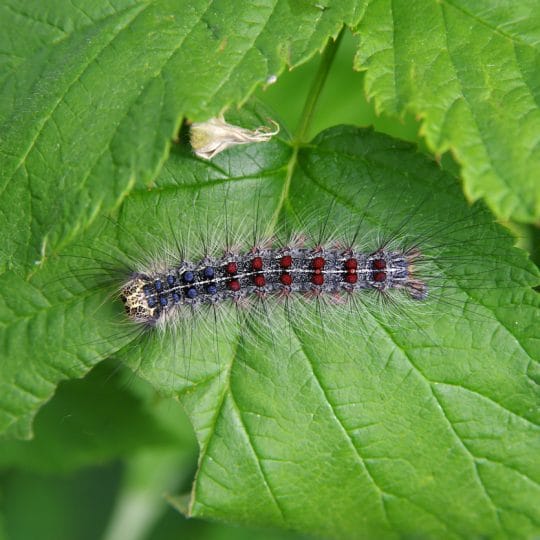Tree Pest Spotlight: Gypsy Moths
Find Out More About This Pesky Pest
Posted
November 25, 2016

Gypsy Moths
One of the most destructive tree pests in Pennsylvania and the notheastern United States, gypsy moths (Lymantria dispar) attack your trees in late spring. By devouring tree leaves, gypsy moths can cause light damage or completely defoliate a tree, rendering it weak and virtually defenseless against other pests and disease. Read on to learn more about the gypsy moth.
Identification
Egg masses: tan-colored teardrop shapes resembling hair that measure 1″ to 1-1/2″ and appear on tree trunks and other outdoor surfaces.
Larvae: young caterpillars begin their lives black or brown in color, measuring about 1/4″L. As they mature, the caterpillars grow black hairs on their backs and typically grow to be about 2-1/2″L. They develop blue bumps along the front of their backs and red bumps toward the back.
Male adults: gray-brown in color with the ability to fly.
Female adults: larger in size, white in color with black markings, cannot fly.
Control
Garden sprays are the most effective weapon in the fight against gypsy moths. It’s important to strike as early as possible, preferably before the eggs reach the larval stage. Spray the affected tree at the first sight of egg masses and repeat applications every few weeks. Gypsy moth traps can be found at garden supply stores to capture adult moths. Insecticidal sprays are also available. These can be applied once a year in the spring to protect your trees from infestation later in the season.
Prevention
Early is always best when combating gypsy moth infestations. Burn or soak egg masses as soon as you see them and be sure to spray trees with insecticide in late fall and early spring (while trees are bare of foliage). You can even look into purchasing a BugBand. This is a device treated with insecticide that wraps around the trunk to keep moths from crawling up a tree.
Stop the Spread of Gypsy Moths
At Elite Tree Care, we work hard to eliminate the presence of gypsy moths on your property. Contact us and we’ll work with you to formulate a plan of attack to protect your trees.